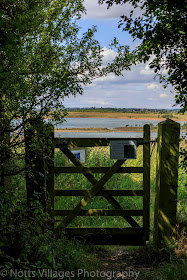Sited close to Staunton is the tiny hamlet of Kilvington. For many years there was opencast gypsum extraction here until the quarry was exhausted in 2004. The pits have filled with water and, at the moment, the site has become a peaceful haven for wildlife. A small corner has been set aside for a bench where birders can view the lake in relative comfort, have a chat and record their sightings on a communal board.
Rumour has it that this is not to last though. The lady in Flawborough and Mrs Staunton both talked of plans for holiday cottages on the site. This will change the look of the place and bring more cars to the area but, on a positive note, it will mean more employment opportunities and the lakes (and wildlife) will be properly managed. We wait to see what happens.
Across the main road and up a short lane you find St Mary's Church. A real country churchyard with lovely large lanterns, straight out of a film set.

We know there was a church here in 1190 because "William, parson of Kilvington" witnessed the Deed of Manumission freeing Hugh Travers to go on Richard I's Crusade in William Staunton's place. According to the Incumbent Board Thomas de Sibthorpe was the incumbent in 1317 (he was murdered in 1351 - see Sibthorpe). John de Sibthorpe was the parson in 1344 but died in 1349 when the Black Death came to the village. Rev John Atkinson was in charge in 1523 but he resigned his post in 1558 probably due to the religious turmoil of the times (it is thought he was unhappy with the idea of a Church of England). So this tiny place has been touched by some historical events.
Kilvington, Alverton and Flawborough have shared close connections with Staunton since the 11th century because of land ownership. The members of the Staunton family are listed on the church incumbents board as early as 1270s. They may have lost control of these neighbouring villages occasionally but they worked to get them back. In 1602 William Staunton mortgaged Kilvington to William Cecil (grandson of Lord Burleigh, Elizabeth I's chief advisor) for £600 to pay the debts of "his extravagent wife". His son, Anthony, bought it back in 1613. Another William Staunton lost it again after the Civil War. Having sided with the Royalists he was fined very heavily so sold his rights to Kilvington.
The religious tensions mentioned earlier meant every parish throughout the country had to report on the number of parishoners; how many were ‘Popish recusants’ (Roman Catholics) and how many refused Holy Communion. In 1676 two Kilvington residents, the blacksmith Edward Richardson and his wife Sarah, were reported as absenting themselves from Communion. Robert Thoroton of Car Colston was a JP. He fined Richardson £10 for attending a Quaker meeting. When he could not pay the bailiffs took his goods to the value of £16 ... this included food, fuel, beds and bedding, even his children's clothes. Even worse they took his work tools. I can not imagine the misery in that empty house. He couldn't even work to feed his family. Thoroton was strongly criticised for his severe treatment of Quakers. The Richardsons managed to survive ... we know this because in 1686 they were reported again for not attending Communion!
Kilvington returned to the Staunton family during the 1700s and was passed down the female line. In 1777 Rev. John Aspinshawe's wife inherited and he changed their name: Rev John became Dr. Staunton. He was incumbent to a number of churches in Nottinghamshire. Obviously he couldn't be in lots of places at once each Sunday and Kilvinghton residents complained he only showed up once a year ... pay day! Services stopped in 1820 and the building fell into disrepair. When Dr Staunton died in 1851 the old church was replaced by the one we see today.
A short distance away is Alverton, one of the smallest villages . Two residents are reported to like the place so much they have refused to leave ... even though they are dead.
The first of these resides in a beautiful house called The Chestnuts. The real life residents report seeing the spirit of an elderly lady in Victorian clothes. The ghost is thought to be Mary Brown who, while employed as a seamstress to Queen Victoria no less, had been called home by her brother after the death of his wife. She returned to Alverton to look after his four children. Apparently she was a very strict guardian .... not a happy situation for anyone then.
The second ghost stalks the old Staunton Church of England School, built in 1881 but now converted into a private house.
This one is reported to be the spirit of a school teacher murdered in the building. The residents hear noises apparently. Sadly, I can't find any reference to such a crime so I can't tell you the gory details.
I can tell you about the son-in-law of Cyrus Andrews, late resident of Alverton Grange. In 1893 Cyrus's daughter, Alice married Athur Henry Tylden-Pattenson. He served through the Zulu War 1879 and through the Battle of Ginginhlovo. Following campaigns in South Africa 1900 - 1901 he was mentioned in Despatches, awarded the Queen's Medal with three clasps, and created a Companion of the Distinguished Service Order: "Arthur Henry Tylden-Pattenson, Major, 3rd Battn. East Kent Regt. In recognition of services during the operations in South Africa." More history on the doorstep.









No comments:
Post a Comment